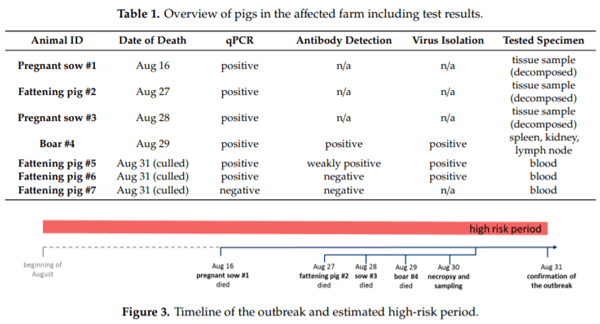African Swine Fever in a Bulgarian Backyard Farm—A Case Report
African swine fever (ASF) is one of the most threatening diseases for the pig farming sector worldwide. As an effective vaccine is lacking, strict application of control measures is the only way to fight the disease in both industrial farms and backyard holdings. With generally low biosecurity standards, the latter are at particular risk for disease introduction and offer challenging conditions for disease control. In the following case report, we describe the overall course of an ASF outbreak in a Bulgarian backyard farm and the implemented control measures. Farm facilities and available data have been investigated to estimate the possible source, spread and time point of virus introduction. Contact with contaminated fomites entering the stable via human activities was regarded to be the most likely introduction route. The slow disease spread within the farm contributes to the hypothesis of a moderate contagiosity. As no further ASF outbreaks have been detected in domestic pig farms in the region, it could be demonstrated that successful disease control in small-scale farms can be reached. Thus, the report contributes to a better understanding of ASF in the backyard sector.
Keywords: African swine fever; backyard sector; case report; ASFV whole-genome sequencing.




1. Wang, T.; Sun, Y.; Qiu, H.J. African swine fever: An unprecedented disaster and challenge to China. Infect. Dis. Poverty 2018, 7, 111. [CrossRef] [PubMed]
2. Penrith, M.L.; Bastos, A.D.S.; Etter, E.; Beltran-Alcrudo, D. Epidemiology of African swine fever in Africa today: Sylvatic cycle versus socio-economic imperatives. Transbound. Emerg. Dis. 2019, 66, 672–686. [CrossRef] [PubMed]
3. Costard, S.; Wieland, B.; de Glanville, W.; Jori, F.; Rowlands, R.; Vosloo, W.; Roger, F.; Pfeiffer, D.U.; Dixon, L.K. African swine fever: How can global spread be prevented? Philos. Trans. R. Soc. B Biol. Sci. 2009, 364, 2683–2696. [CrossRef]
4. Rowlands, R.J.; Michaud, V.; Heath, L.; Hutchings, G.; Oura, C.; Vosloo, W.; Dwarka, R.; Onashvili, T.; Albina, E.; Dixon, L.K. African swine fever virus isolate, Georgia, 2007. Emerg. Infect. Dis. 2008, 14, 1870–1874. [CrossRef]
5. World Bank. World Development Report 2008: Agriculture for Development; World Bank: Washington, DC, USA, 2007.
6. Martinez-Lopez, B.; Alexandrov, T.; Mur, L.; Sanchez-Vizcaino, F.; Sanchez-Vizcaino, J.M. Evaluation of the spatial patterns and risk factors, including backyard pigs, for classical swine fever occurrence in Bulgaria using a Bayesian model. Geospat. Health 2014, 8, 489–501. [CrossRef] [PubMed]
7. Alexandrov, T.; Kamenov, P.; Depner, K. Surveillance and control of classical swine fever in Bulgaria, a country with a high proportion of non-professional pig holdings. Open Agrar 2011, 59, 140–142.
8. Chenais, E.; Sternberg-Lewerin, S.; Boqvist, S.; Liu, L.; LeBlanc, N.; Aliro, T.; Masembe, C.; Ståhl, K.J.T.A.H. African swine fever outbreak on a medium-sized farm in Uganda: Biosecurity breaches and within-farm virus contamination. Trop. Anim. Health Product. 2017, 49, 337–346. [CrossRef]
9. Dione, M.M.; Akol, J.; Roesel, K.; Kungu, J.; Ouma, E.A.; Wieland, B.; Pezo, D. Risk Factors for African Swine Fever in Smallholder Pig Production Systems in Uganda. Transbound. Emerg. Dis. 2017, 64, 872–882. [CrossRef]
10. Bech-Nielsen, S.; Fernandez, J.; Martinez-Pereda, F.; Espinosa, J.; Perez Bonilla, Q.; Sanchez-Vizcaino, J.M. A case study of an outbreak of African swine fever in Spain. Br. Vet. J. 1995, 151, 203–214. [CrossRef]
11. Lamberga, K.; Seržants, M.; Ol,ševskis, E. African swine fever outbreak investigations in a large commercial pig farm in Latvia: A case report. Berl. Münch. Tierärztl. Wochenschr. 2019, 132, 151–155. [CrossRef]
12. FAO Regional Office for Europe and Central Asia. FAO Works to Better Understand Backyard Pig Sector, Key in the Fight Against Swine Fever; Food and Agriculture Organization of the United Nations: Quebec City, QC, Canada, 2018.
13. Council of the European Union. Council Directive 2002/60/EC of 27 June 2002 Laying Down Specific Provisions for the Control of African Swine Fever and Amending Directive 92/119/EEC as Regards Teschen Disease and African Swine Fever; Council Of The European Union: Brussels, Belgium, 2002.
14. Nurmoja, I.; Motus, K.; Kristian, M.; Niine, T.; Schulz, K.; Depner, K.; Viltrop, A. Epidemiological analysis of the 2015–2017 African swine fever outbreaks in Estonia. Prev. Vet. Med. 2018. [CrossRef]
15. Gabriel, C.; Blome, S.; Malogolovkin, A.; Parilov, S.; Kolbasov, D.; Teifke, J.P.; Beer, M. Characterization of African swine fever virus Caucasus isolate in European wild boars. Emerg. Infect. Dis. 2011, 17, 2342–2345. [CrossRef] [PubMed]
16. Nurmoja, I.; Petrov, A.; Breidenstein, C.; Zani, L.; Forth, J.H.; Beer, M.; Kristian, M.; Viltrop, A.; Blome, S. Biological characterization of African swine fever virus genotype II strains from north-eastern Estonia in European wild boar. Transbound. Emerg. Dis. 2017, 64, 2034–2041. [CrossRef] [PubMed]
17. Blome, S.; Gabriel, C.; Beer, M. Pathogenesis of African swine fever in domestic pigs and European wild boar. Virus Res. 2013, 173, 122–130. [CrossRef] [PubMed]
18. Hirata, D.; Doichev, V.D.; Raichev, E.G.; Palova, N.A.; Nakev, J.L.; Yordanov, Y.M.; Kaneko, Y.; Masuda, R. Genetic variation of the East Balkan Swine (Sus scrofa) in Bulgaria, revealed by mitochondrial DNA and Y chromosomal DNA. Anim. Genet. 2015, 46, 209–212. [CrossRef] [PubMed]
19. Forth, J.H.; Forth, L.F.; King, J.; Groza, O.; Hubner, A.; Olesen, A.S.; Hoper, D.; Dixon, L.K.; Netherton, C.L.; Rasmussen, T.B.; et al. A Deep-Sequencing Workflow for the Fast and Efficient Generation of High-Quality African Swine Fever Virus Whole-Genome Sequences. Viruses 2019, 11, 846. [CrossRef]
20. Pietschmann, J.; Guinat, C.; Beer, M.; Pronin, V.; Tauscher, K.; Petrov, A.; Keil, G.; Blome, S. Course and transmission characteristics of oral low-dose infection of domestic pigs and European wild boar with a Caucasian African swine fever virus isolate. Arch. Virol. 2015, 160, 1657–1667. [CrossRef]
21. Chenais, E.; Depner, K.; Guberti, V.; Dietze, K.; Viltrop, A.; Ståhl, K. Epidemiological considerations on African swine fever in Europe 2014–2018. Porc. Health Manag. 2019, 5, 6. [CrossRef]
22. Costard, S.; Mur, L.; Lubroth, J.; Sanchez-Vizcaino, J.M.; Pfeiffer, D.U. Epidemiology of African swine fever virus. Virus Res. 2013, 173, 191–197. [CrossRef]
23. Costard, S.; Zagmutt, F.J.; Porphyre, T.; Pfeiffer, D.U. Small-scale pig farmers’ behavior, silent release of African swine fever virus and consequences for disease spread. Sci. Rep. 2015, 5, 17074. [CrossRef]
24. Brown, V.R.; Bevins, S.N. A Review of African Swine Fever and the Potential for Introduction into the United States and the Possibility of Subsequent Establishment in Feral Swine and Native Ticks. Front. Vet. Sci. 2018, 5, 11. [CrossRef]
25. European Food Safety Authority (EFSA); Boklund, A.; Cay, B.; Depner, K.; Földi, Z.; Guberti, V.; Masiulis, M.; Miteva, A.; More, S.; Olsevskis, E.; et al. Epidemiological analyses of African swine fever in the European Union (November 2017 until November 2018). EFSA J. 2018, 16, e05494.







